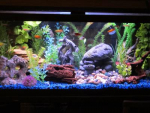Description
Aqueon Tropical Foods provide optimum nutrition for a wide array of tropical fish. They provide a healthy daily diet for proper growth and vitality and bring out natural colors in fish. Available in flakes or granules to accommodate the various feeding habits throughout the water column. Flake food floats at the surface of the water for fish to enjoy. The color enhancing food formula has a higher concentration of ingredients that bring out the colors in fish such as: spirulina, marigold powder, chili powder, and more!
Key Benefits
- Natural ingredients and colors with added vitamins, minerals & trace nutrients
- Nutritious food ingredients that fish are naturally attracted to
- Formulated so that fish utilize more of what they eat and create less waste
- Will not cloud water when fed as directed
- Feed in amounts that fish will consume in under 2 minutes
Ingredients
| Guaranteed Analysis: | |
|---|---|
| Crude Protein (min) | 41% |
| Crude Fat (min) | 7% |
| Crude Fiber (max) | 3% |
| Moisture (max) | 8% |
Ingredients:
Whole Fish Meal (Whole Salmon, Herring & Other Mixed Fishes), Whole Wheat Flour, Soybean Meal, Whole Dried Krill, Wheat Gluten Meal, Dried Yeast, Squid Meal, Kelp Meal, Wheat Germ, Fish Oil, Corn Gluten Meal, Spirulina, Garlic, Natural Astaxanthin, Marigold Powder, Chili Powder, Spinach, Choline Chloride, Calcium Propionate (a Preservative), L-Ascorbyl-2-Polyphosphate (Source of Vitamin C), Vitamin A Acetate, Cholecalciferol (Source of Vitamin D3), Riboflavin Supplement, Vitamin B12 Supplement, Niacin, Menadione Sodium Bisulphite Complex (Source of Vitamin K Activity), Folic Acid, Thiamine, Pyridoxine Hydrochloride (B6), Calcium Pantothenate, Biotin, Dl-Alphatocopherol (E), Manganese Sulfate, Cobalt Sulfate, Ferrous Sulfate, Copper Sulfate.
Useful Information
Feed several times daily in small amounts that will be consumed by fish within 3 minutes.
Fish like variety so feel free to try feeding them different foods over time. Keep in mind that changing foods may take fish some time to get used to. Make sure to feed only what the fish can consume in a few minutes.
FAQ
It depends on the type of fish you have!
Discus, wild caught angelfish, uaru and certain other fish that are found at or near the equator do better at temperatures between 84° and 88° F.
Betta fish thrive best in water temperatures between 76° and 85° F.
Most tropical fish prefer temperatures ranging from 76° to 80° F.
Goldfish, koi and other coldwater fish prefer the temperatures be between 65° and 72° F.
No, simply seeing condensation inside your Aqueon Glass Adjustable Heater does not that it is broken or defective.
Check that the heater is working properly by using a thermometer with your fish tank. (also make sure that the water is the right temperature for the type of fish that you have inside your fish tank)
The reason you may see condensation is because humidity was in the air and trapped inside the tube when it was manufactured and sealed. Your heater is still able to perform properly with this condensation.








